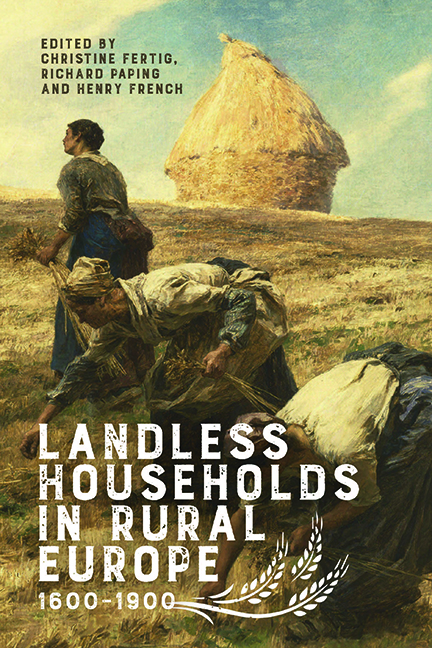Book contents
- Frontmatter
- Contents
- List of Illustrations
- Notes on Contributors
- Preface
- Introduction
- 1 The Treballadors of Girona: Evidence of the Emergence of Wage Labour in Early Modern Catalonia in the Sixteenth and Seventeenth Centuries
- 2 The Squatter Economy of the English Countryside: Building New Landless Communities in England, c. 1600–1900
- 3 The Rise of Landless Households in the Dutch Countryside, c. 1600–1900
- 4 ‘Gaining Ground’ in Flanders after the 1840s: Access to Land and the Coping Mechanisms of Landless and Semi-Landless Households, c. 1850–1900
- 5 Strategies of Survival, Landlessness and Forest Settlement in Flanders: The Forest of Houthulst in a Changing Landscape of Survival (c. 1500–1900)
- 6 Landless and Pauper Households in England, c. 1760–1835: A Comparison of Two Southern English Rural Communities
- 7 Landless Rural Households in France, 1852–1910
- 8 Survival in a Hostile Agrarian Regime: Landless and Semi-Landless Households in Seventeenth-Century Sweden and Finland
- 9 Farming Craftsmen? Access to Land and the Socio-Economic Position of Rural Artisans in Early Modern Finland
- 10 Landlessness and Marriage Restrictions: Tyrol and Vorarlberg in the Eighteenth and Nineteenth Centuries
- 11 Cottages, Barns and Bake Houses: Landless Rural Households in North-Western Germany in the Eighteenth Century
- Bibliography
- Index
- Boydell Studies in Rural History
Introduction
Published online by Cambridge University Press: 08 October 2022
- Frontmatter
- Contents
- List of Illustrations
- Notes on Contributors
- Preface
- Introduction
- 1 The Treballadors of Girona: Evidence of the Emergence of Wage Labour in Early Modern Catalonia in the Sixteenth and Seventeenth Centuries
- 2 The Squatter Economy of the English Countryside: Building New Landless Communities in England, c. 1600–1900
- 3 The Rise of Landless Households in the Dutch Countryside, c. 1600–1900
- 4 ‘Gaining Ground’ in Flanders after the 1840s: Access to Land and the Coping Mechanisms of Landless and Semi-Landless Households, c. 1850–1900
- 5 Strategies of Survival, Landlessness and Forest Settlement in Flanders: The Forest of Houthulst in a Changing Landscape of Survival (c. 1500–1900)
- 6 Landless and Pauper Households in England, c. 1760–1835: A Comparison of Two Southern English Rural Communities
- 7 Landless Rural Households in France, 1852–1910
- 8 Survival in a Hostile Agrarian Regime: Landless and Semi-Landless Households in Seventeenth-Century Sweden and Finland
- 9 Farming Craftsmen? Access to Land and the Socio-Economic Position of Rural Artisans in Early Modern Finland
- 10 Landlessness and Marriage Restrictions: Tyrol and Vorarlberg in the Eighteenth and Nineteenth Centuries
- 11 Cottages, Barns and Bake Houses: Landless Rural Households in North-Western Germany in the Eighteenth Century
- Bibliography
- Index
- Boydell Studies in Rural History
Summary
Landless families have been an essential part of European rural society for a very long time. In most historical contexts, numerous landless people took part in local and regional labour markets and supported the workforce of farmers. Landless families usually lived in their own households, although single-parent families sometimes lived as lodgers in larger households. ‘Landlessness’ means that people had no or very little control over land. This common feature could take different forms, depending on regional, social and individual variations. Landless families often rented tiny houses, with very small pieces of land, mostly gardens, at best. Sometimes, they had to make do with less living space, some renting only small parts of houses, or single rooms, or even a small corner of the barn or the baking house. In those cases, the use of landed property was not always part of the rental agreement, hence families in the countryside sometimes faced a total lack of access to land. In other words: their control of land, either through property rights or formal arrangements like lease contracts, was negligible. This does not necessarily mean that there was no access to land at all – local peasants and farmers could allow for gleaning on harvested fields, for example, or livestock could be brought to commons even without formal access.
Our definition of landless households will be those families that had neither property rights on nor other formal control over cultivable land, apart from small gardens around the house. In this book, we will often also include near landless rural households, who had very limited access to land, though in no way enough to sustain a family. Both groups have in common that they needed substantial external sources of revenue for making a living.
In many European regions, population grew at least from the sixteenth or seventeenth century onwards, and this population growth mostly enlarged the share of landless or near landless households in the countryside. Social inequality in the countryside was subject to strong regional variation and determined the access of social groups to landed property. Inheritance practices played a central role here: in regions with impartible inheritance, the number of farms hardly increased. Consequently, many descendants of landowners experienced downward mobility and fell into the status of landless day labourers.
- Type
- Chapter
- Information
- Landless Households in Rural Europe, 1600-1900 , pp. 1 - 11Publisher: Boydell & BrewerPrint publication year: 2022



